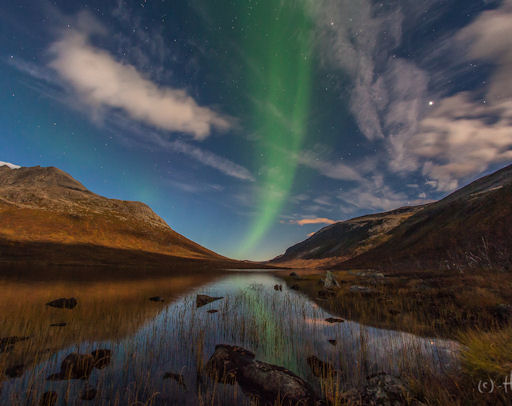Thirty-five new items have just been added to our Meteorite Jewelry collection. Browse the Space Weather Store for something out of this world. | | |
CME IMPACT: A coronal mass ejection (CME) hit Earth's magnetic field on Sept. 30th at 10:25 UT. The impact was weak, lifting the solar wind speed around Earth barely above 300 km/s. Nevertheless, auroras are possible around the Arctic Circle as Earth's magnetic field reverberates from the impact. Ground stations in Norway are picking up disturbances in the geomagnetic field that usually herald Northern Lights. Aurora alerts: text, voice.
This morning, Helge Mortensen photographed these auroras shining through bright moonlight over Kvaløya, Norway:

"These auroras appeared just before the CME impact," says Mortensen. "We hope to see the real fireworks on Sunday evening."
Realtime Aurora Photo Gallery
ISS COMPANION: Europe's massive ATV-3 cargo carrier undocked from the International Space Station (ISS) on Sept. 28th. Now the spacecraft, as large as a double-decker bus, is leading the ISS in orbit around Earth. Monika Landy-Gyebnar saw it this morning flying over Veszprem, Hungary:

"I went outside to see the ISS," says Landy-Gyebnar. "About a minute before the space station appeared, I saw a realtively bright object flying overheads almost where the ISS was to fly. Then I remembered that the ATV-3 undocked from ISS on Friday--and there it was! Just as ATV-3 has faded, the ISS emerged from the clouds and followed the small cargo vehicle towards the east."
The ATV-3 will reenter Earth's atmosphere on or about October 3rd, disintegrating in a spectacular fireball over the Pacific Ocean. Until then, sky watchers should be alert for the cargo vessel leading the ISS across the night sky. ISS flyby predictions may be found on the web or on your smartphone.
Realtime Space Weather Photo Gallery
Realtime Noctilucent Cloud Photo Gallery
[previous years: 2003, 2004, 2005, 2006, 2007, 2008, 2009, 2011]
Potentially Hazardous Asteroids (
PHAs) are space rocks larger than approximately 100m that can come closer to Earth than 0.05 AU. None of the known PHAs is on a collision course with our planet, although astronomers are finding
new ones all the time.
On September 30, 2012 there were 1332 potentially hazardous asteroids.
Notes: LD means "Lunar Distance." 1 LD = 384,401 km, the distance between Earth and the Moon. 1 LD also equals 0.00256 AU. MAG is the visual magnitude of the asteroid on the date of closest approach. | | The official U.S. government space weather bureau |
| | The first place to look for information about sundogs, pillars, rainbows and related phenomena. |
| | Researchers call it a "Hubble for the sun." SDO is the most advanced solar observatory ever. |
| | 3D views of the sun from NASA's Solar and Terrestrial Relations Observatory |
| | Realtime and archival images of the Sun from SOHO. |
| | from the NOAA Space Environment Center |
| | the underlying science of space weather |

